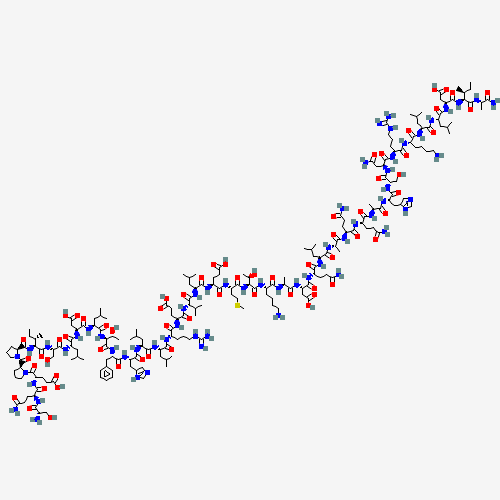| Pharmaceutical Information |
| Drug Name |
Corticorelin ovine triflutate |
| Drug ID |
BADD_D00530 |
| Description |
Corticorelin, available commercially as corticorelin ovine triflutate (tradename Acthrel), is a synthetic form of the peptide human corticotropin-releasing hormone (hCRH), a potent stimulator of adrenocorticotropic hormone (ACTH) release from the anterior pituitary. Endogenous forms hCRH are involved in the stress response and its main function is stimulation of the pituitary to release ACTH.
It is used as a diagnostic agent to evaluate the status of the pituitary-adrenal axis in the differentiation of a pituitary source from an ectopic source of excessive ACTH secretion. It provides a differential diagnosis for Cushing's disease (a pituitary source of ACTH excess) or of ectopic ACTH syndrome (an ectopic source of ACTH excess). If corticorelin injection results in an increase of plasma ACTH and cortisol, the patient is diagnosed with Cushing's disease. However, if corticorelin injection does not result in an increase of plasma ACTH and cortisol, the patient is diagnosed with ectopic ACTH syndrome. |
| Indications and Usage |
Corticorelin is indicated for use in differentiating pituitary and ectopic production of ACTH in patients with ACTH-dependent Cushing's syndrome. |
| Marketing Status |
approved |
| ATC Code |
Not Available |
| DrugBank ID |
DB09067
|
| KEGG ID |
D03592
|
| MeSH ID |
C085671
|
| PubChem ID |
16132344
|
| TTD Drug ID |
Not Available
|
| NDC Product Code |
52416-102 |
| UNII |
56X54T817Q
|
| Synonyms |
corticorelin ovine | corticorelin ovine triflutate | Acthrel |
|
| Chemical Information |
| Molecular Formula |
C205H339N59O63S |
| CAS Registry Number |
79804-71-0 |
| SMILES |
CCC(C)C(C(=O)NC(CO)C(=O)NC(CC(C)C)C(=O)NC(CC(=O)O)C(=O)NC(CC(C)C)C(=O)NC(C(C)O)C
(=O)NC(CC1=CC=CC=C1)C(=O)NC(CC2=CN=CN2)C(=O)NC(CC(C)C)C(=O)NC(CC(C)C)C(=O)NC(CCC
NC(=N)N)C(=O)NC(CCC(=O)O)C(=O)NC(C(C)C)C(=O)NC(CC(C)C)C(=O)NC(CCC(=O)O)C(=O)NC(C
CSC)C(=O)NC(C(C)O)C(=O)NC(CCCCN)C(=O)NC(C)C(=O)NC(CC(=O)O)C(=O)NC(CCC(=O)N)C(=O)
NC(CC(C)C)C(=O)NC(C)C(=O)NC(CCC(=O)N)C(=O)NC(CCC(=O)N)C(=O)NC(C)C(=O)NC(CC3=CN=C
N3)C(=O)NC(CO)C(=O)NC(CC(=O)N)C(=O)NC(CCCNC(=N)N)C(=O)NC(CCCCN)C(=O)NC(CC(C)C)C(
=O)NC(CC(C)C)C(=O)NC(CC(=O)O)C(=O)NC(C(C)CC)C(=O)NC(C)C(=O)N)NC(=O)C4CCCN4C(=O)C
5CCCN5C(=O)C(CCC(=O)O)NC(=O)C(CCC(=O)N)NC(=O)C(CO)N |
| Chemical Structure |

|
|
| ADRs Induced by Drug |
|
|
*The priority for ADR severity classification is based on FAERS assessment, followed by the most severe level in CTCAE rating. If neither is available, it will be displayed as 'Not available'.
**The 'Not Available' level is hidden by default and can be restored by clicking on the legend twice.
|
|
|

